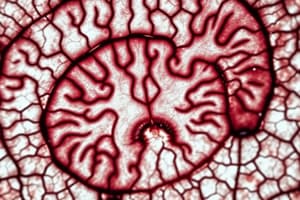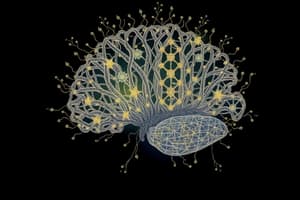Podcast
Questions and Answers
What effect did 0.3 𝜇M perampanel have on AMPA receptor-mediated synaptic transmission?
What effect did 0.3 𝜇M perampanel have on AMPA receptor-mediated synaptic transmission?
- Increase in synaptic transmission
- Complete inhibition of synaptic transmission (correct)
- Partial inhibition of synaptic transmission
- No effect on synaptic transmission
In the experiments, what dosage of GYKI 52466 was used?
In the experiments, what dosage of GYKI 52466 was used?
- 10 𝜇M (correct)
- 20 𝜇M
- 15 𝜇M
- 5 𝜇M
Which parameter was measured to assess the effect of perampanel?
Which parameter was measured to assess the effect of perampanel?
- Synaptic transmission frequency
- Calcium ion flux
- EPSP slope (correct)
- Receptor density
Which outcome was not associated with the application of 0.3 𝜇M perampanel according to the provided information?
Which outcome was not associated with the application of 0.3 𝜇M perampanel according to the provided information?
What does f-EPSP stand for in the context of this study?
What does f-EPSP stand for in the context of this study?
How does high-frequency stimulation affect the population spikes recorded in St.p?
How does high-frequency stimulation affect the population spikes recorded in St.p?
What does a decrease in amplitude of f-EPSPs recorded in St.r indicate?
What does a decrease in amplitude of f-EPSPs recorded in St.r indicate?
Which measure is considered appropriate for assessing the efficacy of synaptic transmission after the termination of AV?
Which measure is considered appropriate for assessing the efficacy of synaptic transmission after the termination of AV?
What happens to distortions of measurements over time concerning f-EPSPs and PSs?
What happens to distortions of measurements over time concerning f-EPSPs and PSs?
What does an increase in amplitude of population spikes suggest about neural activity?
What does an increase in amplitude of population spikes suggest about neural activity?
How is the slope of f-EPSP measured?
How is the slope of f-EPSP measured?
What is the consequence of high-frequency stimulation on the efficacy of synaptic transmission?
What is the consequence of high-frequency stimulation on the efficacy of synaptic transmission?
What is primarily observed in St.r in response to population spikes?
What is primarily observed in St.r in response to population spikes?
What concentration of perampanel was applied to reduce AMPA receptor-mediated f-EPSPs?
What concentration of perampanel was applied to reduce AMPA receptor-mediated f-EPSPs?
Which compound does not affect the slope of AMPA receptor-mediated f-EPSPs when present with perampanel?
Which compound does not affect the slope of AMPA receptor-mediated f-EPSPs when present with perampanel?
What was observed regarding the effectiveness of perampanel during the wash-in period?
What was observed regarding the effectiveness of perampanel during the wash-in period?
During the wash-out of perampanel, what condition was noted regarding recovery?
During the wash-out of perampanel, what condition was noted regarding recovery?
Which statement is true regarding perampanel’s effect on AMPA receptor-mediated responses?
Which statement is true regarding perampanel’s effect on AMPA receptor-mediated responses?
What does 'n = 2 and 3' signify in the context of the study findings?
What does 'n = 2 and 3' signify in the context of the study findings?
Which effect did application of 0.3 µM perampanel NOT produce?
Which effect did application of 0.3 µM perampanel NOT produce?
What does the term 'IC50' represent in the context of drug inhibition?
What does the term 'IC50' represent in the context of drug inhibition?
What was the IC50 value reported for the AMPA receptor inhibition?
What was the IC50 value reported for the AMPA receptor inhibition?
Which experimental condition displayed the highest concentration of drug used?
Which experimental condition displayed the highest concentration of drug used?
What does the notation 'n=4' signify in the experimental groups?
What does the notation 'n=4' signify in the experimental groups?
How many different drug concentrations were tested for the control group in the experiments?
How many different drug concentrations were tested for the control group in the experiments?
What type of receptor is being studied through the experiments described?
What type of receptor is being studied through the experiments described?
What is the significance of the green traces in the provided data?
What is the significance of the green traces in the provided data?
What is the implication of the range given with the IC50 value (0.18-0.3 µM)?
What is the implication of the range given with the IC50 value (0.18-0.3 µM)?
What type of cells make up the primary structure of the hippocampus?
What type of cells make up the primary structure of the hippocampus?
When stimulating the Schaffer collaterals, which layers of the CA1 area show predictable responses?
When stimulating the Schaffer collaterals, which layers of the CA1 area show predictable responses?
What characterizes the field potentials recorded from the stratum oriens in area CA1 during weak fiber activation?
What characterizes the field potentials recorded from the stratum oriens in area CA1 during weak fiber activation?
What is the significance of the sink and source identified in current source density (CSD) analysis?
What is the significance of the sink and source identified in current source density (CSD) analysis?
Which receptor type is primarily responsible for mediating the slope of the field excitatory postsynaptic potential (f-EPSP) in the CA1 area?
Which receptor type is primarily responsible for mediating the slope of the field excitatory postsynaptic potential (f-EPSP) in the CA1 area?
What does the presynaptic fiber volley (affernet volley) from the stratum radiatum indicate?
What does the presynaptic fiber volley (affernet volley) from the stratum radiatum indicate?
What structure is mainly involved when recording responses in the CA1 hippocampal slice?
What structure is mainly involved when recording responses in the CA1 hippocampal slice?
What is the primary response observed when the Schaffer collaterals are stimulated?
What is the primary response observed when the Schaffer collaterals are stimulated?
What was the effect of 10 𝜇M perampanel on NMDA receptor-mediated f-EPSP?
What was the effect of 10 𝜇M perampanel on NMDA receptor-mediated f-EPSP?
What was the percentage of baseline response for f-EPSP at 1 𝜇M D-AP5?
What was the percentage of baseline response for f-EPSP at 1 𝜇M D-AP5?
How did the effects of 10 𝜇M perampanel and 1 𝜇M D-AP5 compare statistically?
How did the effects of 10 𝜇M perampanel and 1 𝜇M D-AP5 compare statistically?
What does the data suggest about perampanel's effect on kainate receptor-mediated responses?
What does the data suggest about perampanel's effect on kainate receptor-mediated responses?
At what concentration does D-AP5 provide a full block of NMDA receptor-mediated f-EPSP?
At what concentration does D-AP5 provide a full block of NMDA receptor-mediated f-EPSP?
Which of the following drugs was used in conjunction with 10 𝜇M perampanel in the experiments?
Which of the following drugs was used in conjunction with 10 𝜇M perampanel in the experiments?
What was the purpose of using a paired t-test in the experiment?
What was the purpose of using a paired t-test in the experiment?
What does the abbreviation f-EPSP stand for?
What does the abbreviation f-EPSP stand for?
Flashcards
Perampanel's effect on AMPA receptors
Perampanel's effect on AMPA receptors
A drug that completely blocks the transmission of signals through AMPA receptors at a concentration of 3 𝜇M.
f-EPSP slope
f-EPSP slope
A measure of the rate of change of the f-EPSP, which reflects the strength of synaptic transmission.
AMPA receptor
AMPA receptor
A type of glutamate receptor critical for excitatory synaptic transmission in the brain.
GYKI 52466
GYKI 52466
Signup and view all the flashcards
f-EPSP (field excitatory postsynaptic potential)
f-EPSP (field excitatory postsynaptic potential)
Signup and view all the flashcards
Long-term potentiation (LTP)
Long-term potentiation (LTP)
Signup and view all the flashcards
Synaptic depression (STP)
Synaptic depression (STP)
Signup and view all the flashcards
Slope of the f-EPSP
Slope of the f-EPSP
Signup and view all the flashcards
f-EPSP (fiber-evoked EPSP)
f-EPSP (fiber-evoked EPSP)
Signup and view all the flashcards
Population spikes (PS)
Population spikes (PS)
Signup and view all the flashcards
Amplitude of the f-EPSP
Amplitude of the f-EPSP
Signup and view all the flashcards
Effect of HFS on population spikes
Effect of HFS on population spikes
Signup and view all the flashcards
Effect of HFS on f-EPSP amplitude
Effect of HFS on f-EPSP amplitude
Signup and view all the flashcards
IC50
IC50
Signup and view all the flashcards
Concentration-response curve
Concentration-response curve
Signup and view all the flashcards
Antagonist
Antagonist
Signup and view all the flashcards
Complete inhibition
Complete inhibition
Signup and view all the flashcards
Perampanel
Perampanel
Signup and view all the flashcards
Laminar organization of the hippocampus
Laminar organization of the hippocampus
Signup and view all the flashcards
Stratum pyramidale (st.p.)
Stratum pyramidale (st.p.)
Signup and view all the flashcards
Stratum radiatum (st.r.)
Stratum radiatum (st.r.)
Signup and view all the flashcards
Current source density (CSD) analysis
Current source density (CSD) analysis
Signup and view all the flashcards
Afferent volley (AV)
Afferent volley (AV)
Signup and view all the flashcards
Field excitatory postsynaptic potential (f-EPSP)
Field excitatory postsynaptic potential (f-EPSP)
Signup and view all the flashcards
What is perampanel?
What is perampanel?
Signup and view all the flashcards
What are AMPA receptors?
What are AMPA receptors?
Signup and view all the flashcards
What was the effect of perampanel in the experiment?
What was the effect of perampanel in the experiment?
Signup and view all the flashcards
What is f-EPSP?
What is f-EPSP?
Signup and view all the flashcards
Is the effect of perampanel dependent on stimulation?
Is the effect of perampanel dependent on stimulation?
Signup and view all the flashcards
What was observed during the washout period?
What was observed during the washout period?
Signup and view all the flashcards
What is Cyclothiazide (CTZ)?
What is Cyclothiazide (CTZ)?
Signup and view all the flashcards
What is NBQX?
What is NBQX?
Signup and view all the flashcards
Perampanel's Lack of Effect on f-EPSPs
Perampanel's Lack of Effect on f-EPSPs
Signup and view all the flashcards
D-AP5 Effect on NMDA Receptors
D-AP5 Effect on NMDA Receptors
Signup and view all the flashcards
Statistical Test Comparison
Statistical Test Comparison
Signup and view all the flashcards
Perampanel's Lack of Effect on Kainate Receptors
Perampanel's Lack of Effect on Kainate Receptors
Signup and view all the flashcards
What are Popspikes?
What are Popspikes?
Signup and view all the flashcards
Drugs Used in the Experiment
Drugs Used in the Experiment
Signup and view all the flashcards
Measuring Neuronal Activity
Measuring Neuronal Activity
Signup and view all the flashcards
Study Notes
Hippocampal Slice Preparation
- Transverse hippocampal slices are prepared from either dorsal or ventral poles of rodent hippocampi.
- The brain is cooled to approximately 4°C in artificial cerebrospinal fluid (ACSF).
- The hippocampi are dissected free.
- Transverse slices are prepared using a McIlwain Tissue Chopper.
- The slices are allowed to recover at room temperature for 2 hours before recordings.
Pharmacological Dissection of Field Responses
- Learning Outcomes:
- Introduce hippocampal slice preparation.
- Discuss field EPSPs in the CA1 area of the Schaffer collaterals and their analyses.
- Discuss pharmacological isolation and characterization of excitatory field potentials in the hippocampus.
- Discuss measurements and quantification of PPF, STP, and LTP.
- Discuss quantitative pharmacological and physiological studies using field potentials.
The Tri-synaptic Circuit of the Hippocampus
- The hippocampus is arranged in a very orderly fashion.
- The tri-synaptic circuitry of the hippocampus is well preserved in transverse hippocampal slices.
- Granule cells (GCs) receive synaptic input from the entorhinal cortex (PP) and send axons (mossy fibers) to activate CA3 pyramidal cells.
- CA3 pyramidal cells axons (Schaffer collaterals, Sch) innervate the CA1 pyramidal cells.
Pyramidal Cells of the Hippocampus
- Cell bodies of granule cells (not shown), CA3, and CA1 pyramidal neurons, and their dendrites and axons are arranged in a laminar fashion.
- When stimulating the Schaffer collaterals at the border between CA3 and CA1 areas, predictable biological responses to single electric stimuli can be recorded in the stratum pyramidale (st.p.) and the stratum radiatum (st.r.) of the CA1 area.
Current Source Density (CSD) Analysis
- Field potentials evoked by weak activation of fibers projecting to stratum oriens in area CA1, evoking a pure synaptic response without a superimposed population spike.
- CSD analysis reveals a sink (positive) in stratum oriens and a source (negative) in the cell body layer and proximal dendrites.
- The extracellular field EPSP reflects intracellular events, but is phase-advanced with respect to the intracellular EPSP.
Extracellular Recording in the Hippocampal Slice
- The stratum radiatum (St.r.) responses are comprised of a negative going presynaptic fiber volley (afferent volley, AV) that reflects synchronized action potentials.
- The AV is followed by the field excitatory postsynaptic potential (f-EPSP), the slope of which is primarily mediated by AMPA receptors.
- The St.p. waveform is composed of a positive f-EPSP that is followed by a negative going synchronized action potential discharge in CA1 pyramidal neuron bodies (population spike, PS).
- PS is positive in the St.r. and affects the measurement of the peak negative amplitude of the f-EPSP.
Basic Pharmacology of Evoked f-EPSPs
- f-EPSPs evoked by stimulation of the Schaffer collaterals are dependent on neurotransmitter release and can be abolished by removal of extracellular Ca2+.
- f-EPSPs also depend on the opening of ionotropic receptors, demonstrated by application of a broad spectrum excitatory amino acid inhibitor (kynurenate).
- Kynurenate abolishes f-EPSPs while preserving the afferent volley (AV).
Paired Pulse Facilitation of f-EPSPs
- When two stimuli are given at a short interval (IPI), the second response has a steeper slope than the first due to increased probability of neurotransmitter release.
- A ratio of the slopes of the two f-EPSPs can estimate the amount of paired pulse facilitation (PPF).
- The application of GABAA receptor antagonist picrotoxin has no effect on early f-EPSP slope measurements, indicating that inhibitory neurotransmission does not affect f-EPSP measurements.
- Picrotoxin application produces epileptiform activity.
Short- and Long-Term Potentiation of f-EPSPs
- f-EPSP slope increases after high-frequency stimulation (e.g., theta-burst stimulation).
- High-frequency stimulation decreases latency and increases amplitude of population spikes.
- Population spikes reduce the amplitude of early f-EPSPs, indicating that the early slope of f-EPSPs is the appropriate measure of synaptic transmission efficiency.
- Distortions of measurements become less significant over time, as magnitudes of f-EPSPs and latencies of population spikes decrease.
Pharmacological Isolation of Field Responses
- Details of experiments and results related to pharmacological isolation of field responses and the effects on different types of responses are given.
Case Study - Perampanel
- Perampanel's effect on AMPA receptor-mediated transmission is not use-dependent, meaning the action occurs independently of prior stimulation.
- Application of perampanel decreases AMPA receptor-mediated f-EPSPs but does not affect their decay time.
- Perampanel's action on AMPA receptor-mediated f-EPSPs is independent of stimulation during wash-in and wash-out.
Perampanel is More Potent than GYKI 52466
- Perampanel (IC50 = 0.23 µM) is significantly more potent than GYKI 52466 (IC50 = 7.82 µM) in inhibiting AMPA receptor-mediated f-EPSPs.
Perampanel Has No Effect on NMDA Receptor-Mediated f-EPSPs
- Perampanel doesn't affect NMDA receptor-mediated f-EPSPs.
- D-AP5 (NMDA receptor antagonist) significantly inhibits NMDA receptor-mediated f-EPSPs.
Perampanel Has No Effect on Kainate Receptor-Mediated Responses
- Perampanel doesn't affect kainate receptor-mediated responses.
- NBQX (kainate receptor antagonist) blocks the facilitation of population spikes evoked by activation of kainate receptors.
Example Questions L6
- Q1: What is the molecular target of AP5?
- (A) NMDA receptor
Studying That Suits You
Use AI to generate personalized quizzes and flashcards to suit your learning preferences.
Related Documents
Description
This quiz covers the process of preparing transverse hippocampal slices from rodent brains and analyzing field responses in the CA1 area. You will explore pharmacological dissection, including the characterization of excitatory field potentials and the quantitative study of phenomena such as paired-pulse facilitation and long-term potentiation. Test your understanding of these crucial processes in neurophysiology.




